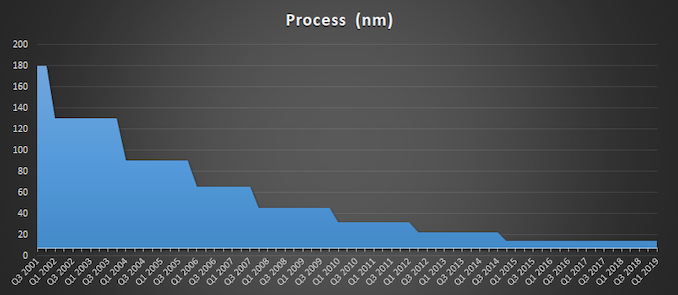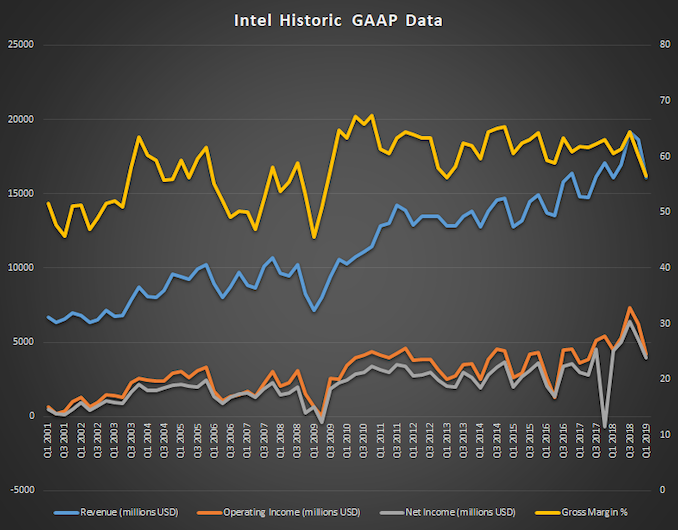Intel Reports Q1 FY 2019 Results: Revenue Flat, PCs Up, Servers Down
by Brett Howse on April 25, 2019 9:45 PM EST- Posted in
- CPUs
- Intel
- Financial Results

This afternoon, Intel announced their earnings for Q1 of their 2019 fiscal year. Revenue for the first quarter came in at $16.1 billion, which is flat compared to Q1 2018, but margins were down 4% to 56.6%. Due to this, operating income was down 7% to $4.2 billion, and net income was down 11% to $4.0 billion. Earnings-per-share for the quarter were $0.87, down 6% from $0.93 a year ago.
| Intel Q1 2019 Financial Results (GAAP) | |||||
| Q1'2019 | Q4'2018 | Q1'2018 | |||
| Revenue | $16.1B | $18.7B | $16.1B | ||
| Operating Income | $4.2B | $6.2B | $4.5B | ||
| Net Income | $4.0B | $5.2B | $4.5B | ||
| Gross Margin | 56.6% | 60.2% | 60.6% | ||
| Client Computing Group Revenue | $8.6B | -12% | +4% | ||
| Data Center Group Revenue | $4.9B | -20% | -6% | ||
| Internet of Things Revenue | $910M | +11% | +8% | ||
| Non-Volatile Memory Solutions Group | $915M | -17% | -12% | ||
| Programmable Solutions Group | $486M | -21% | -2% | ||
Despite a PC market that continues to struggle, Intel made gains in the first quarter with their Client Computing Group. On both notebooks and desktops, Intel volumes were down 7% and 8% respectively, but thanks to higher average selling prices (ASP) Intel’s PC-centric business did grow revenue. Notebook processor ASP was up 13% compared to Q1 2018, and desktop ASP was 7% higher. This increased revenue for this segment 4% overall to $8.5 billion. Intel cites strength in gaming, larger commercial, and modem for the growth.
As we’ve already covered, Intel’s push to 10 nm has finally started to see some gains in volume after years of delay, and we should finally start to see Ice Lake powered laptops this fall.
Intel’s Data Center group was down 6% to $4.9 billion in revenue this quarter. Cloud continued to grow, up 5%, but it could not offset the decline in enterprise and government revenue, which was down 21% this quarter. At the end of the day, you can’t have both cloud and on-prem revenue gains forever, since the former is designed to eat the latter, but we’ll have to watch this over the next while and see if this is a one-year blip, or signs of a larger trend.
Internet of Things continued its growth, with revenue up 8% to $910 million. What was once a blip on the radar is almost a billion dollar per quarter market for Intel. MobileEye revenue was up 38% to $209 million, which is a record for this segment.
Intel’s non-volatile storage business was down 12% to $915 million, reflecting the increased competition in pricing of NAND.
Finally, Intel’s Programmable Solutions Group, which includes their Altera FPGAs, was down 2%.
Looking ahead to Q2, Intel is forecasting revenue of approximately $15.6 billion, with an operating margin of 27%, and the FY 2019 forecast is for approximately $69 billion in revenue, with an operating margin of 30%.
Source: Intel Investor Relations












18 Comments
View All Comments
Dragonstongue - Friday, April 26, 2019 - link
almost seems "odd" if you look at it, like "magically" a very large increase in % for many things, especially tech which has more or less been trending upwards and I know for the past 4 generations let alone since Ryzen is almost "odd" that new buyers of sorts come out of the wood works and/or it is because older equipment, new installations etc just happened all at once in burst over the past year and a 1/2 .. 2 odd years (from budget to gaming to enthusiast to ultra high end if you have to ask you cant afford it work grade)Interesting to say the least especially what may or may not transpire 2019-2021 is going to be a massive landscape shift from everyone, including governments and so forth, hell at the way things are going many of us simply will not be in a financial state to think of anything but survival (the times look very harsh outlook)
anyways
^.^
yannigr2 - Friday, April 26, 2019 - link
You can't call gains, the lower volumes. For shareholders increased revenue can be seen as gains, but for everyone else, lower numbers of processors do not translate into gains. Add to that the lower profit margin and things look even less as "gains".10nm for low end mobile processors? This is old news. They just try to say the same story from a different perspective. Wake me up when they can make desktop, high wattage, many cores CPUs at 10nm or 7nm.
outsideloop - Friday, April 26, 2019 - link
Realistically, 10nm is dead at this point:https://www.digitaltrends.com/computing/intel-10nm...
And Charlie called it last year:
https://semiaccurate.com/2018/10/22/intel-kills-of...
And IMO, this revenue adjustment down will be AMD's revenue adjustment up in four days.
eva02langley - Friday, April 26, 2019 - link
That article is sooo good... and this is what we get after from Intel.https://arstechnica.com/gadgets/2018/10/report-int...
Media reports published today that Intel is ending work on the 10nm process are untrue. We are making good progress on 10nm. Yields are improving consistent with the timeline we shared during our last earnings report.
— Intel News (@intelnews) October 22, 2018
Intel managed communication with shareholders. They didn't canceled 10nm, but this process is not going to replace 14nm. They mislead the shareholders for not making the stock drop.
I will believe 10nm is going to be real when they release the first Xeon on 10nm.
DanNeely - Friday, April 26, 2019 - link
Charlie updated his killed conclusion in January.TL;DR he concluded it was dead in October after learning that of the 4 planned 10nm fabs 1 was being turned into a 14nm fab, 2 were getting 7nm levels of EUV tools, and there was total silence on the 4th. He assumed that meant 10nm was completely dead; but subsequently found out the 4th was staying at 10nm. OTOH the 75% reduction in planned fab capacity means Intel won't be making a lot of 10nm anytime soon. This is in agreement with the recently leaked roadmap showing 14nm continuing for a few more years in most product segments.
https://www.semiaccurate.com/2019/01/25/why-semiac...
psychobriggsy - Friday, April 26, 2019 - link
Intel down 12% in two days now - shows the effect of the leaked slides, the complete admission that 10nm is going to be limited to low volume mobile processors because of performance issues and not having many 10nm fabs after refactoring them to 14nm and 7nm.name99 - Friday, April 26, 2019 - link
"Internet of Things continued its growth, with revenue up 8% to $910 million. What was once a blip on the radar is almost a billion dollar per quarter market for Intel. "But that's extremely misleading, isn't it? For Intel IoT is effectively cloud services, no?
How much of the IoT revenue actually comes from the sale of hardware (or SW) that goes into the IoT devices, as opposed to data warehouse backend stuff that aggregates and processes IoT data?
ballsystemlord - Saturday, April 27, 2019 - link
Have we discerned yet (Ian's review[1]) if 10nm is a more preformant and/or power efficient node or worse?[1]: https://www.anandtech.com/show/13405/intel-10nm-ca...